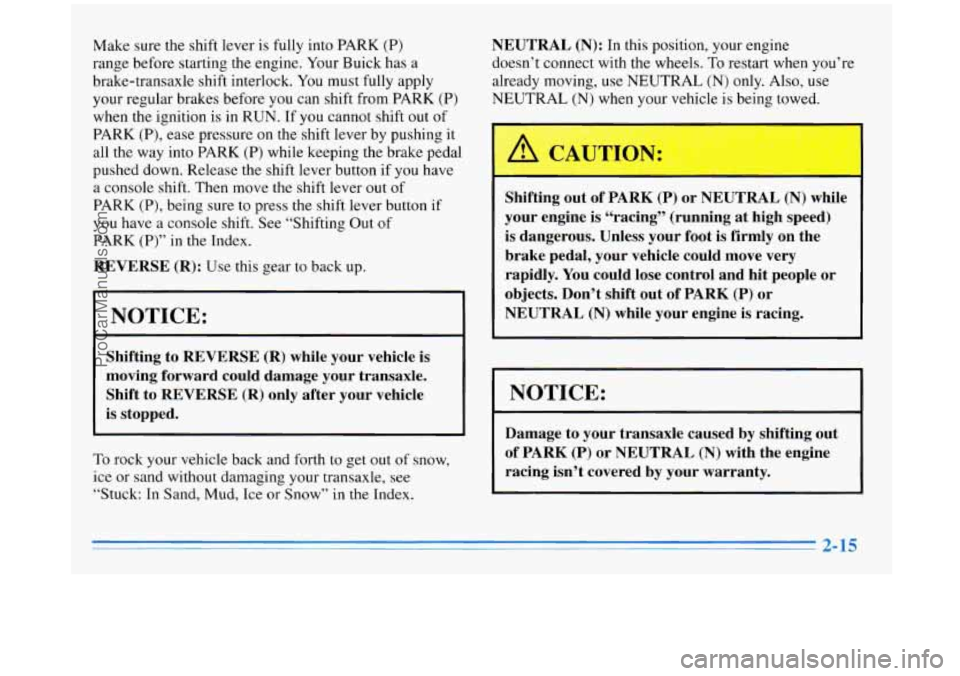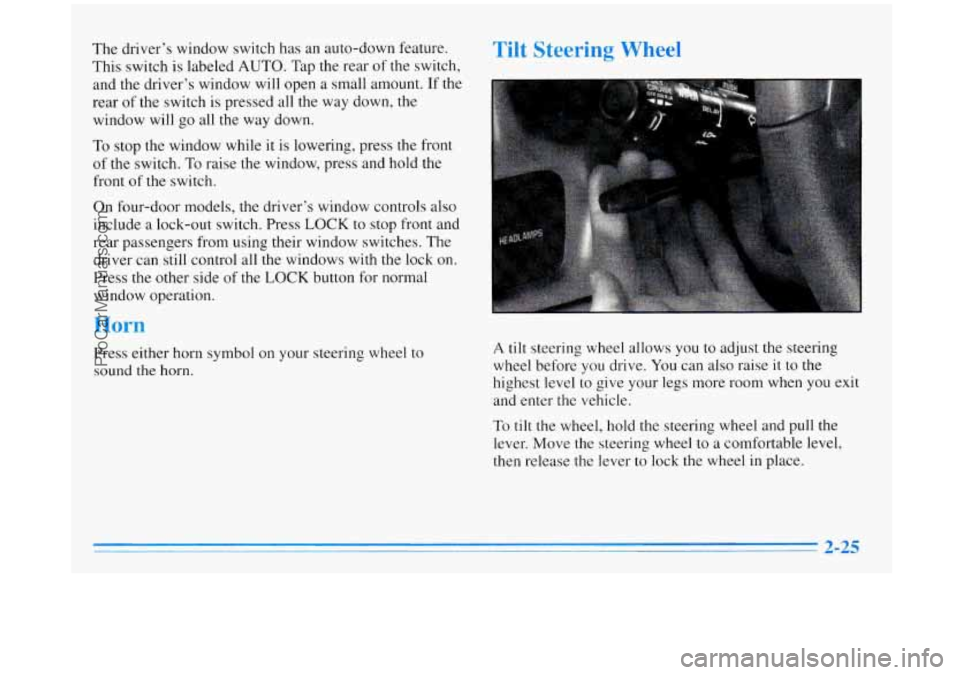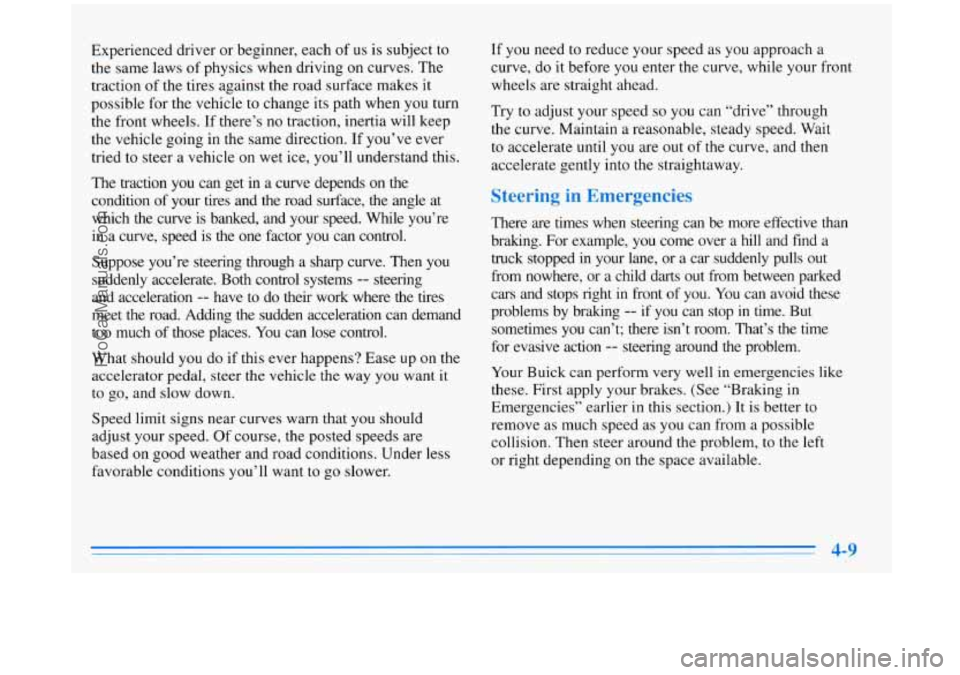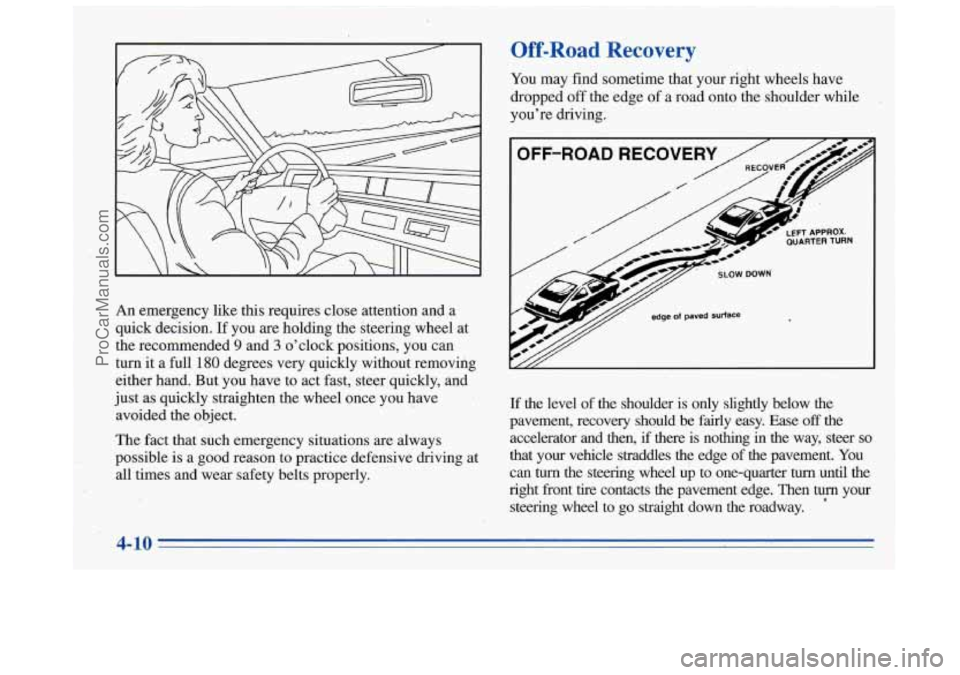Page 81 of 356

Make sure the shift lever is fully into PARK (P)
range before starting the engine. Your Buick has a
brake-transaxle shift interlock. You must fully apply
your regular brakes before you can shift from PARK
(P)
when the ignition is in RUN. If you cannot shift out of
PARK (P), ease pressure on the shift lever by pushing it
all the way into PARK (P) while keeping the brake pedal
pushed down. Release the shift lever button
if you have
a console shift. Then move the shift lever
out of
PARK (P), being sure to press the shift lever button if
you have a console shift. See “Shifting Out of
PARK (P)” in the Index.
REVERSE (R): Use this gear to back up.
NOTICE:
I
Shifting to REVERSE (R) while your vehicle is
moving forward could damage your transaxle.
Shift to REVERSE (R) only after your vehicle
is stopped.
To rock your vehicle back and forth to get out of snow,
ice or sand without damaging your transaxle,
see
“Stuck: In Sand, Mud, Ice or Snow” in the Index.
NEUTRAL (N): In this position, your engine
doesn’t connect with the wheels. To restart when you’re
already moving, use NEUTRAL (N) only.
Also, use
NEUTRAL
(N) when your vehicle is being towed.
Shifting out of PARK (P) or NEUTRAL (N) while
your engine is “racing” (running
at high speed)
is dangerous. Unless your foot is firmly on the
brake pedal, your vehicle could move very
rapidly. You could lose control and hit people or
objects. Don’t shift out of PARK
(P) or
NEUTRAL
(N) while your engine is racing.
I NOTICE:
r
Damage to your transaxle caused by shifting out
of PARK
(P) or NEUTRAL (N) with the engine
racing isn’t covered by your warranty.
ProCarManuals.com
Page 83 of 356

SECOND (2): This position gives you more power but
lower fuel economy. You can use SECOND
(2) on hills.
It can help control your speed
as you go down steep
mountain roads, but then you would
also want to use
your brakes
off and on.
NOTICE:
Don’t drive in SECOND (2) for more than
25 miles (41 km), or at speeds over 55 mph
(88 km/h), or you can damage your transaxle.
Use AUTOMATIC OVERDRIVE
(@) or
THIRD (3) as much as possible.
Don’t shift into SECOND
(2) unless you are
going slower than
65 mph (105 km/h), or you can
damage your engine. FIRST
(1): This
position gives you even more power
(but lower
fuel economy) than SECOND (2). You can
use it on very steep hills, or in deep snow or mud. If the
shift lever
is put in FIRST ( 1 ), the transaxle won’t shift
into first gear
until the vehicle is going slowly enough.
NOTICE:
If your front wheels can’t rotate, don’t try to
drive. This might happen if you were stuck in
very deep sand or mud or were up against
a solid
object. You could damage your transaxle.
Also, if you stop when going uphill, don’t hold
your vehicle there with only the accelerator
pedal. This could overheat and damage the
transaxle. Use your brakes or shift into PARK
(P)
to hold your vehicle in position on a hill.
2-17
ProCarManuals.com
Page 91 of 356

The driver’s window switch has an auto-down feature.
This switch is labeled
AUTO. Tap the rear of the switch,
and the driver’s window will open a small amount. If the
rear of the switch is pressed all the way down,
the
window will go all the way down.
To stop the window while
it is lowering, press the front
of
the switch. To raise the window, press and hold the
front of the switch.
On four-door models, the driver’s window controls also
include
a lock-out switch. Press LOCK to stop front and
rear passengers from using their window switches. The
driver can still control all the windows with the lock
on.
Press the other side of the LOCK button for normal
window operation.
rn
Press either horn symbol on your steering wheel to
sound the horn.
Tilt St,,l ing Wheel
A tilt steering wheel allows you to adjust the steering
wheel before you drive. You can also raise it to the
highest
level to give your legs more room when you exit
and enter the vehicle.
To
tilt the wheel, hold the steering wheel and pull the
lever. Move the steering wheel to
a comfortable level,
then release the lever to lock the wheel in place.
- 2-25
ProCarManuals.com
Page 95 of 356
Cruise Control
A CAUT1,ON:
Cruise control can be dangerous where you
can’t drive safely
at a steady speed. So,
don’t use your cruise control on winding
roads. or in heavy traffic.
Cruise, control can be dangerous
on
slippery roads. On such roads, fast changes
in tire traction can cause needless wheel
spinning, and you could lose control. .Don’t
use cruise control
on slippery roads.
With cruise control, you can rqaintain a speed of about
25 mph (40 km/h) or more without keeping your foot
on the accelerator.
This can really help on long trips.
Cruise control does not work at speeds below about
25 mph (40 km/h).
When you apply your brakes, the cruise control
shuts
off.
2-29
ProCarManuals.com
Page 147 of 356
Steering Wheel Controls tion)
You can control certain audio system functions using the
buttons on your steering wheel.
SEEK: Press the up or down arrows to tune to the
next or previous radio station. If a tape or compact
disc
is playing, the player will advance to the next or
previous selection.
SCAN: Press to listen to stations for a few seconds. The
radio will
go to a station, stop for a few seconds, then go
on to the next station. Press again to stop scanning.
AM FM: Press to choose AM, FM 1 or FM2. If a
tape or disc is playing, press this button to hear the
radio instead.
VOL: Press the up or down arrows to increase or
decrease volume.
SRCE: Press to change to the tape or disc function
when the radio is on.
MUTE: Press to silence the audio system.
3-23
.~
ProCarManuals.com
Page 159 of 356
Here’s how anti-lock works. Let’s say the road is wet.
You’re driving safely. Suddenly an animal jumps
out in
front
of you.
You slam on the brakes. Here’s what happens with ABS.
A computer senses that wheels are slowing down. If one
of the wheels is about to stop rolling, the computer will
separately work the brakes at each front wheel and at the
rear wheels. The
anti-lock system can change the brake pressure faster
than any driver could.
The computer is programmed to
make the most
of available tire and road conditions.
I
You can steer around the obstacle while braking hard.
As you brake, your computer keeps receiving updates on
wheel speed and controls braking pressure accordingly.
ProCarManuals.com
Page 161 of 356

Experienced driver or beginner, each of us is subject to
the same laws of physics when driving
on curves. The
traction of
the tires against the road surface makes it
possible for the vehicle to change its path when you turn
the front wheels.
If there’s no traction, inertia will keep
the vehicle going in the same direction. If you’ve ever
tried
to steer a vehicle on wet ice, you’ll understand this.
The traction
you can get in a curve depends on the
condition of your tires and the road surface, the angle at which the curve is banked, and your speed. While you’re
in a curve, speed is the one factor you can control.
Suppose you’re steering through a sharp curve. Then you
suddenly accelerate. Both control systems
-- steering
and acceleration
-- have to do their work where the tires
meet the road. Adding the sudden acceleration can demand
too much of those places. You can lose control.
What should
you do if this ever happens? Ease up on the
accelerator pedal, steer the vehicle the way
you want it
to go, and slow down.
Speed limit signs near curves warn that you should
adjust your speed. Of course, the posted speeds are
based on good weather and road conditions. Under less
favorable conditions you’ll want to go slower. If
you need to reduce your speed as you approach a
curve, do it before you enter the curve, while your front
wheels are straight ahead.
Try to adjust your speed
so you can “drive” through
the curve. Maintain a reasonable, steady speed. Wait
to accelerate until
you are out of the curve, and then
accelerate gently into the straightaway.
’Steering in Emergencies
There are times when steering can be more effective than
braking. For example, you come over a hill and find
a
truck stopped in your lane, or a car suddenly pulls out
from nowhere, or a child darts out from between parked
cars and stops right in front of you. You can avoid these
problems by braking
-- if you can stop in time. But
sometimes you can’t; there isn’t room. That’s the time
for evasive action
-- steering around the problem.
Your Buick can perform very well in emergencies like
these. First apply your brakes. (See “Braking in
Emergencies” earlier in this section.) It is better to
remove as much speed as you can from
a possible
collision.
Then steer around the problem, to the left
or right depending on the space available.
ProCarManuals.com
Page 162 of 356

An emergency like this requires close attention and a
quick decision. If you
are holding the steering wheel at
the recommended
9 and 3 o’clock positions, you can
turn it a full
180 degrees very quickly without removing
either hand. But
you have to act fast, steer quickly, and
just as quickly straighten the wheel o,nce you have
avoided the object.
The fact that such emergency situations
are always
possible is a good reason to practice defensive driving at
all times and wear safety belts properly.
Off-Road Recovery
You may find sometime that your right wheels have
dropped off the edge of a road onto the shoulder while
you’re driving.
If the level of the shoulder is only slightly below the
pavement, recovery should be fairly easy. Ease
off the
accelerator and then, if there is nothing
in the way, steer so
that your vehicle straddles the edge of the pavement. You
can turn the steering wheel up to one-quarter turn until the
right front tire contacts the pavement edge. Then turn your
steering wheel
to go straight down the roadway.
4-10
ProCarManuals.com